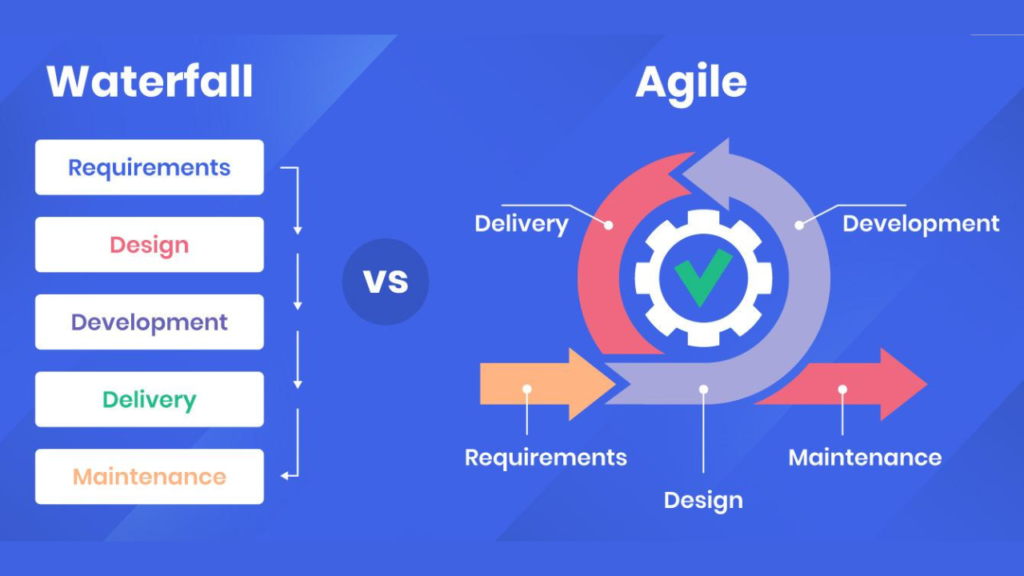Read about Agile vs Waterfall project management methodologies in this blog. Know when to use Agile and Waterfall methodologies. You will also learn the key differences between Waterfall and Agile, and know their pros and cons.

Agile and Waterfall are two of the most popular project management methodologies in use these days. The Agile technique emphasizes flexibility, collaboration, and variation; it allows groups to work together and adapt to adjustments at some stage in the venture instead of the conventional Waterfall method, which follows a strictly linear process.
Agile is all about approximately turning down costs incrementally and continuously to meet patron desires and exceed expectations. The Waterfall method, alternatively, follows a strictly linear system in which every segment of the venture must be completed before the next one starts. It is highly desirable for tasks with well-described objectives and a clear give-up goal.
Agile vs. Waterfall project management is a popular subject matter when it comes to task management, and both methodologies are used to achieve the intention of a successful venture, but the technique and blessings are distinct.
What is Waterfall?
Waterfall is a software development method in which improvements are completed linearly and sequentially. In Waterfall, improvement is split into distinct phases, such as necessities accumulating, layout, implementation, checking out, and renovation. Each segment must be finished before the following one can start, and there may be limited opportunities to head down and make changes to previous levels. Waterfall is well-suited for initiatives with nicely described and unchanging requirements but may be inflexible and difficult to evolve to accommodate converting requirements.
What is Agile?
Agile is a project management methodology that prioritizes flexibility, adaptability, and consumer delight. It is a popular approach for software program improvement and has been widely adopted in many industries. The Agile method encourages teams to work together and adapt to changes in the course of the task. Agile is all about delivering value incrementally and continuously to meet consumer desires and exceed expectations.
There are numerous Agile frameworks, including Scrum, Kanban, and Lean, that groups can pick from to help enforce the Agile approach. These Agile frameworks offer a set of guidelines and quality practices for teams to observe and help them work together and adapt to changes for the duration of the venture.
Agile vs Waterfall: A Head-to-Head Comparison of Project Management Methodologies
Agile and Waterfall are famous task control methodologies, each with their own unique methods and benefits. So, Agile emphasizes flexibility and collaboration, allowing groups to evolve and make adjustments throughout the mission, whereas Waterfall follows a strictly linear process and is first-class ideal for initiatives with well-defined targets and a clear aim.
Both methodologies have their advantages, and the choice of technique will depend upon the particular necessities of the project and the group’s desire. Agile is suitable for projects that require flexibility and adaptability, while Waterfall is better suited for projects with nicely described targets and a clean abandonment intention. It is vital to understand the key variations between Agile and Waterfall and tailor the approach accordingly to ensure successful task delivery.
Deciding Between Agile and Waterfall
Agile is acceptable for initiatives that require flexibility and adaptability. It is good for initiatives that have quite a few unknowns and where the scope and requirements may also alternate at some stage in the venture. Agile is likewise well-suited for projects that contain a lot of collaboration between team contributors, which includes software program development projects or product development initiatives.
Waterfall, however, is highly desirable for initiatives that have properly described targets and a clear give-up goal. It is ideal for projects in which the scope and requirements are properly understood, which includes creation tasks or manufacturing tasks. The waterfall is also properly acceptable for tasks that have hard and fast finances and timelines and wherein modifications to the scope or necessities could have a giant effect on the undertaking.
Understanding 6 Core Differences
Approach
Agile: Agile emphasizes flexibility and collaboration, allowing teams to adapt to modifications all through the undertaking.
Waterfall: Follows a strictly linear system, wherein each phase needs to be completed before the subsequent one starts.
Deliverables
Agile: Delivers costs incrementally and constantly to meet client desires and exceed expectations.
Waterfall: Delivers an entire product at the end of the project, intending to satisfy well-described targets and a clean give-up goal.
Team Structure
Agile: Teams are go-functional and self-organizing.
Waterfall: Teams are typically divided into separate stages, with each section managed by a unique group.
Testing and Quality Assurance
Agile: Testing and excellent assurance are included for the duration of the improvement method.
Waterfall: Testing and the best guarantee are achieved at the end of the improvement technique.
Adaptability
Agile: Allows for changes to the scope and necessities at some stage in the task.
Waterfall: This does not permit adjustments to the scope and requirements once the venture has all started.
Project Planning
Agile: It prioritizes flexibility and makes use of short planning cycles.
Waterfall: It prioritizes predictability and makes use of long-term planning cycles.
Tailoring Project Management: The Advantages of Agile and Waterfall for Various Teams
When it involves the benefits of Agile and Waterfall, specific groups may additionally experience specific blessings depending on the form of the mission and their precise needs. Agile is satisfactory and perfect for initiatives that require flexibility and adaptability, while Waterfall is more acceptable for projects with well-defined targets and a clear end goal. Agile allows teams to work closely with stakeholders and clients, ensuring that the venture is meeting their wishes. Waterfall’s strict linear technique can help teams stay on track, meet closing dates, and manipulate higher. Ultimately, the choice of method will depend on the unique necessities of the assignment and the group’s desire.
Agile vs Waterfall: Pros and Cons
Agile
Pros:
- Allows for flexibility and adaptability at some point in the project.
- Encourages collaboration and teamwork.
- Delivers price incrementally and continuously
- Helps teams reply quickly to adjustments and patron desires.
- Integrates testing and satisfactory guarantee during the development technique.
Cons:
- It can be difficult to devise and finance long-term projects.
- This may also result in scope creep if no longer managed properly.
- Can be tough for groups that are not used to running in an agile environment.
Waterfall
Pros:
- Provides a clear linear technique and shape.
- Allows for higher management and manipulation of the project.
- Helps teams stay on course and meet closing dates.
- provides a clear separation of levels.
Cons:
- As soon as the venture has begun, it no longer allows for adjustments to the scope and necessities.
- Testing and pleasant assurance are done at the end of the development method.
- Maybe this is much less appropriate for projects that require flexibility and adaptability.
Conclusion
Agile and Waterfall are popular venture control methodologies, each of which has its own particular approaches and benefits. Agile emphasizes flexibility and collaboration, allowing teams to adapt to adjustments at some point in the challenge, even as Waterfall follows a strictly linear procedure and is a quality desirable for projects with properly defined goals and a clear end intention.
Both methodologies have their blessings, and the selection of technique will depend upon the particular requirements of the assignment and the crew’s choice. Agile is best suited for initiatives that require flexibility and adaptability, while Waterfall is better suited for initiatives with properly defined targets and a clear quit intention. Ultimately, the purpose of each methodology is to deliver a successful assignment, but the method is one of a kind. It is essential to recognize the key differences between Agile and Waterfall and tailor the approach accordingly to ensure success when undertaking transportation.
Frequently Asked Questions
1. What is the real difference between Agile and Waterfall?
Agile focuses on flexibility, collaboration, and adaptability, as the value is delivered incrementally throughout the project. Such projects are well-suited for projects that involve changing requirements.
Waterfall is a linear and sequential methodology that requires finishing one phase before the other one can be started. Ideal for projects with clearly stated goals and stable requirements.
2. When should I apply Agile over Waterfall?
Apply Agile when:
- Project requirements are likely to change or evolve.
- Continuous customer feedback is necessary.
- Teams need to collaborate and quickly adapt to change.
Apply Waterfall when:
- Project budgets, timelines, and requirements are fixed.
- The end result is well-defined and will not change.
- You prefer a structured, linear workflow.
3. Can Agile and Waterfall be used together?
This is called a hybrid approach. Some projects can be realized through the usage of Waterfall for well-defined phases (e.g., planning) and Agile for the phases that demand flexibility (e.g., development). These approaches allow teams to take advantage of both methodologies applied.
4. What sectors employ Agile most?
Agile is used, especially in the software development sector, marketing sector, production development sector, the finance and fintech sector. It is suited for dynamic sectors, with an urgent need for updates and customer-centric solutions.
5. Is Waterfall still applicable in the current contemporary of project management?
Yes, Waterfall applies best to projects which
- Multiple clear deliverables and milestones.
- A fixed budget and timeline.
- A small scope for alterations such as construction and manufacturing projects.
6. What are the advantages and disadvantages of using the Agile methodology?
Advantages
- Adapts to change easily.
- Fosters collaboration and teamwork.
- Encourages quality assurance throughout the process.
Disadvantages
- Unfamiliar teams have a hard time working with this process.
- High risk for scope creep if not managed.
- Hard to estimate long-term project costs and timelines.
7. Can you apply Agile to large-scale projects?
Yes, Agile can scale for big projects by using frameworks like SAFe (Scaled Agile Framework) or LeSS (Large-Scale Scrum). These frameworks give ways to manage complexity while sticking to Agile principles.
8. How do Agile and Waterfall influence project timelines?
Agile: Flexible and iterative, timelines depend on feedback and requirements evolution.
Waterfall: Timelines are fixed, as the start and end points are easy to define and fix
9. How can I make an appropriate choice of methodology for my project?
- Are requirements likely to change?
- Do they prefer frequent updates or a final deliverable?
- Are budgets and timelines fixed or flexible?
10. What are the biggest impediments to teams making the transition from Waterfall to Agile?
- Resistance from teams and stakeholders to change.
- The learning curve for Agile tools and practices.
- Adjusting to a non-linear, iterative workflow.
Proper training and support can address the challenges to ensure that the teams transition successfully.

Hardik follows the interface between content, growth, and operations as part of his role at ValueX2. His career as a copywriter made him believe that, “while great content is well-written, it also needs to be well-positioned in the digital landscape”. Therefore, he sometimes views his role as connecting the dots between strategy, audience psychology, data-backed execution, and planning.
Hardik has created content for brands in the EdTech, corporate tax consultancy, and eCommerce sectors. He is currently exploring Agile and Scrum methodologies to infuse greater agility and structure into content development and delivery processes.






